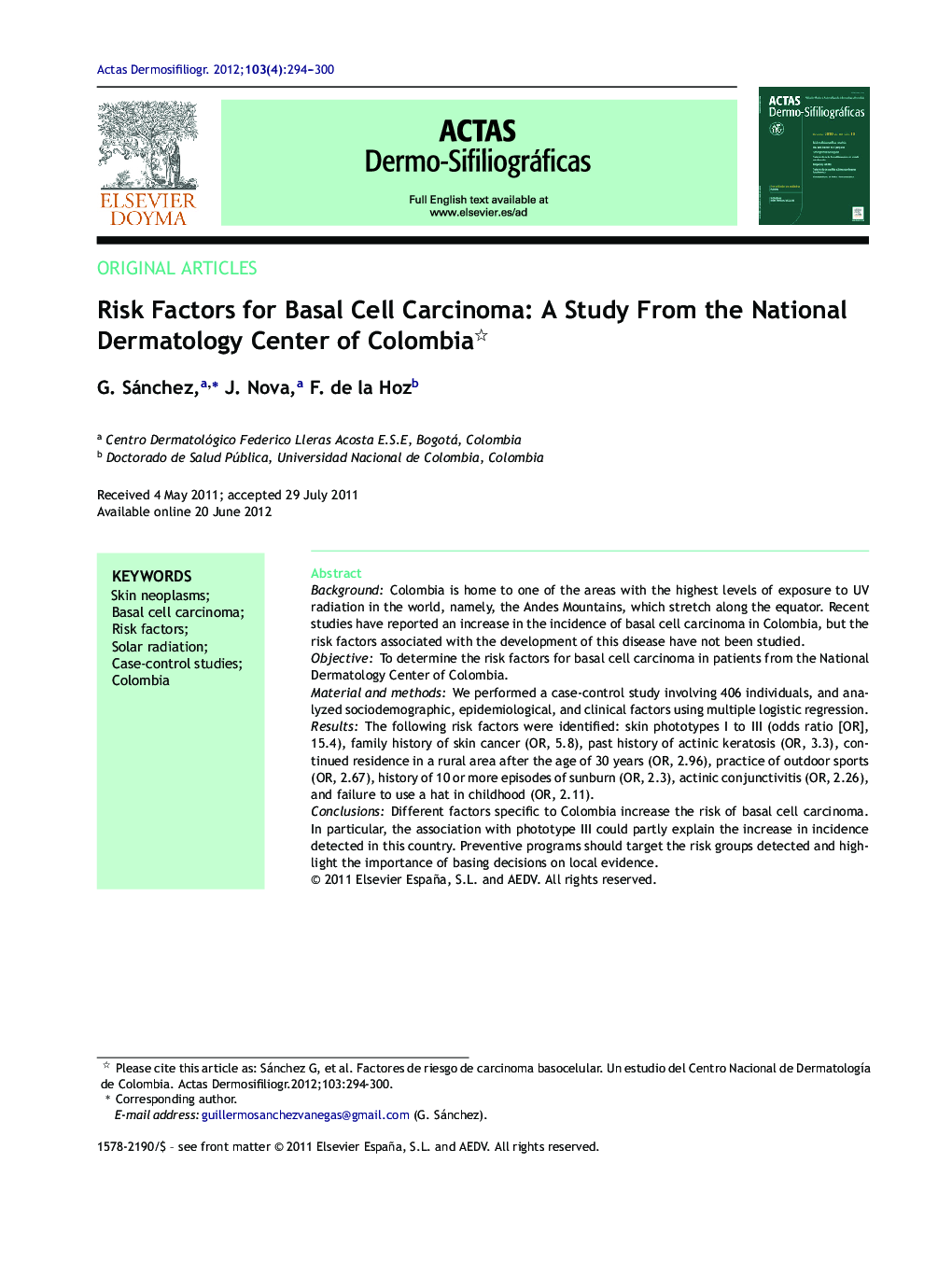| کد مقاله | کد نشریه | سال انتشار | مقاله انگلیسی | نسخه تمام متن |
|---|---|---|---|---|
| 3183338 | 1200696 | 2012 | 7 صفحه PDF | دانلود رایگان |

BackgroundColombia is home to one of the areas with the highest levels of exposure to UV radiation in the world, namely, the Andes Mountains, which stretch along the equator. Recent studies have reported an increase in the incidence of basal cell carcinoma in Colombia, but the risk factors associated with the development of this disease have not been studied.ObjectiveTo determine the risk factors for basal cell carcinoma in patients from the National Dermatology Center of Colombia.Material and methodsWe performed a case-control study involving 406 individuals, and analyzed sociodemographic, epidemiological, and clinical factors using multiple logistic regression.ResultsThe following risk factors were identified: skin phototypes I to III (odds ratio [OR], 15.4), family history of skin cancer (OR, 5.8), past history of actinic keratosis (OR, 3.3), continued residence in a rural area after the age of 30 years (OR, 2.96), practice of outdoor sports (OR, 2.67), history of 10 or more episodes of sunburn (OR, 2.3), actinic conjunctivitis (OR, 2.26), and failure to use a hat in childhood (OR, 2.11).ConclusionsDifferent factors specific to Colombia increase the risk of basal cell carcinoma. In particular, the association with phototype III could partly explain the increase in incidence detected in this country. Preventive programs should target the risk groups detected and highlight the importance of basing decisions on local evidence.
ResumenIntroducciónSobre el paralelo ecuatorial, en la cordillera de los Andes, se localiza una de las áreas con la radiación ultravioleta más alta del planeta. Colombia se encuentra en esta ubicación, y recientemente se ha documentado para este país un incremento en las tasas de carcinoma basocelular; sin embargo no se han estudiado en esta población los factores asociados con el desarrollo de esta neoplasia.ObjetivoEstablecer factores de riesgo de carcinoma basocelular en pacientes del Centro Nacional de Dermatología de Colombia.Material y métodosSe realizó un estudio de casos y controles, incluyendo 406 sujetos. Se estudiaron factores sociodemográficos, epidemiológicos y clínicos. Para el análisis se empleó el método de regresión logística.ResultadosSe identificaron los siguientes factores de riesgo: fototipos I al III (OR: 15,4), antecedente familiar de cáncer de piel (OR: 5,8), antecedente de queratosis actínicas (OR: 3,3), vivir en área rural incluso después de los 30 años (OR: 2,96), practicar deportes al aire libre (OR: 2,67), historia de 10 o más quemaduras solares (OR: 2,3), conjuntivitis actínica (OR: 2,26), y no utilizar sombrero en la infancia (OR: 2,11).ConclusiónExisten diferentes factores propios del contexto colombiano que incrementan el riesgo de carcinoma basocelular. Se destaca la asociación con el fototipo III, que podría explicar parte del fenómeno de incidencia creciente en el país. Las acciones preventivas se deben enfocar a los grupos de riesgo detectados, resaltando la importancia de tomar decisiones basadas en la evidencia local.
Journal: Actas Dermo-Sifiliográficas (English Edition) - Volume 103, Issue 4, May 2012, Pages 294–300